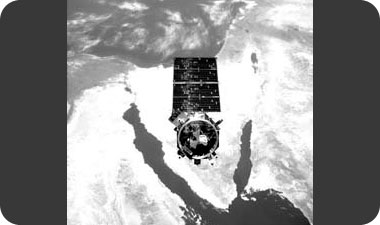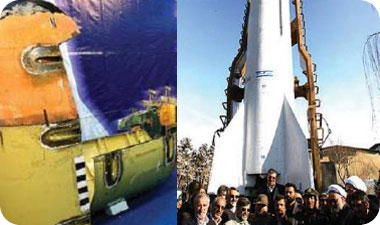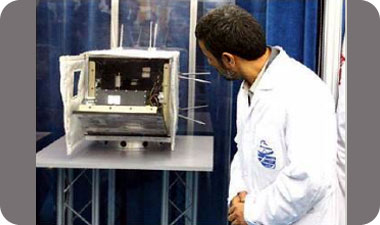On the Iranian space program, its motives and goals for the coming years * Tal Inbar's article as it appeared in Galileo about a month ago * and in addition an update on the disclosure of a secret launch site revealed in satellite images
The British newspaper The Times published on Friday (11/4/08) that new satellite images reveal a secret site where Iran is apparently developing long-range missiles that can hit targets in Europe. The site is called "Missile Research Site". Iran claims that last week it conducted a test of a "research missile" on the spot, in preparation for launching a satellite into space. According to the analysis of the new photographs, this is a missile launch site. The launch of the missile was carried out in the presence of the President of Iran, Mahmoud Ahmadinejad.
Experts estimate that at the site Iran is focusing on developing missiles that can reach a distance of about 6,000 kilometers. These missiles will be able to hit targets in Israel and Europe. The connection between the launch site and the missile program was revealed by the intelligence magazine "Janes". Dr. Jeff Forden, a researcher at the Massachusetts Institute of Technology, said that a 40-meter-long structure was recently erected in the area of the site, similar to the structure erected at the missile launch site in North Korea. "This is a facility with a high security classification and strategic importance."
About a month and a half ago, representatives of the Atomic Energy Agency claimed to Iran that they had evidence that Tehran was testing plans to mount nuclear warheads on ballistic missiles. Iran strongly denied.
The Iranian hope in space
Tal Inbar, Galileo, March 2008

Monday, February 4.2.2008, XNUMX, was a historic day in Iranian terms, and it is very possible that its consequences will go beyond the boundaries of this radical Islamic state. Iranian President Mahmoud Ahmadinejad, Defense Minister Najjar and other government officials inaugurated on this day the new Iranian Space Center, dedicated to missile tests, a satellite tracking station, and an integration facility for Iranian satellites.
Not only that during the visit of the presidential entourage to the facility a ballistic missile was launched to a high altitude, but that Iran simultaneously unveiled a new space launch missile, which was not known until then, and for the "dessert" a small self-developed satellite was presented, and the date of its launch into space was even hinted at. The Israeli reader has been used to reading about the Iranian missile program for years, in the context of ballistic missiles carrying warheads; It seems that the latest revelations from Tehran justify turning the spotlight on the Iranian space program, understanding its background, motives and goals for the coming years.
In 1998, a model of a satellite launcher was presented at an arms exhibition in Tehran, along with a simple model of a satellite. It was the first tangible manifestation of an Iranian plan to develop a satellite launcher. A year later, Iran officially declared its desire to develop an independent capability to launch objects into space. The head of the Iranian Space Agency reiterated this at a conference sponsored by the United Nations, which dealt with the issue of space and was held in Iran in 2004. Iran has a branch space establishment, led by a committee for space research, headed by the country's president. Many defense industries are partners in Iran's space ventures, and various government ministries take part in building the human and technological infrastructure designed to support the country's various space programs.
The reasons for Iran's entry into space
Developing countries see a national space program as a means to improve international and regional status, to strengthen the country's technological capacity as part of the strengthening process, to strengthen local industry and create new economic possibilities, to improve the well-being of the population (for example by using satellite communications) and to use remote sensing satellites to address environmental problems. Iran aspires to be an important force both in the regional system and in the international system. In order to achieve this status, Iran is engaged in the development of long-range missiles and a nuclear program and maintains a space program, which dates back to the days of the Shah's rule in the XNUMXs.
Iran's activity in space stopped with the fall of the Shah's regime in January 1979, and was renewed under the leadership of the revolution in the nineties of the 20th century. Already in the mid-sixties, the Shah expressed interest in a visit by American astronauts to Iran as part of attempts to get closer to the United States. At the same time, Iranian scientists expressed a desire to take part in the American space program, the Apollo program. The United States did not respond to these requests.
In the mid-seventies, Iran appealed to the United States to help it establish an Iranian space agency. In October 1974, a memorandum of understanding was signed in Tehran between the United States and Iran for the transfer of information from the Landsat satellite (the first commercial remote sensing satellite, developed by NASA) to Iran, through a ground station to receive information from the satellite, to be built near Tehran. The station was established in the late seventies, and began receiving test broadcasts to test its competence. However, these were stopped at the beginning of January 1979 following the revolution.
The ability to launch an object into space has clear strategic significance. A country possessing such a capability is actually capable of hitting any point on the planet. Iran's success in developing and launching a satellite on its own would be a breakthrough for it. Only a very limited number of countries have so far managed to launch a satellite on their own. An independent Iranian launch would be for Iran an entrance ticket to a very prestigious club of the launching countries. In the regional arena, a national Iranian space program that includes the development of satellites and whose launch will be a response to the Israeli space program.
Iran's activity is not directed towards Israel alone. Iran also wants status and influence in the Muslim world. The domestic national arena will also be affected by the demonstration of independent space capabilities. Iran's success in developing a satellite on its own and launching it into space will help the Iranian government unite the Iranian public and strengthen Iranian national pride. Such a success would legitimize Ahmadinejad's policies and strengthen his power and status at home.

A cover for the ballistic missile program
The Iranian Ministry of Defense plays a central role in shaping Iran's space program. In December 2003, Iran established the Supreme Council for Space Affairs, which is chaired by the President of Iran, and whose members are the central ministers of the Iranian government, including the Minister of Defense.
The Ministry of Defense participates in the ambitions to develop local capabilities for developing satellites and launching them into space, and is the body responsible for the Shihab ballistic missile program, which Iran uses as a basis for developing a satellite launcher. It will be emphasized that the Iranian preoccupation in the field of space launchers serves, among other things, as a cover for its programs in the field of ballistic missiles, and a tool for circumventing various limitations regarding the transfer of diverse missile technologies.
The first Iranian satellite
Iran is the 43rd country to own a satellite. On October 27, 2005, the Sinah 1 satellite was successfully launched, which Iran purchased from the Ukrainian Yuzhnoi company and which was launched into space on a Russian launcher. It is a remote sensing satellite that weighs 160 kilograms.
The Iranians announced that it was a civilian satellite whose purpose was to photograph Iran and help monitor natural disasters and especially earthquakes, but a few weeks after its launch, the head of Iran's space agency stated that the satellite was capable of spying on Israel. This statement is mainly propaganda, since the satellite's capabilities to photograph Israel with a resolution that allows for the production of operational information is only marginal.
Masbah - the lucky satellite
In the field of remote sensing, a microsatellite named Mesbah (which means lighthouse in Persian) was built for Iran, weighing about 60 kilograms. The satellite was built by the Italian Carlo Gavazzi company in collaboration with research bodies in Iran. This satellite was supposed to fly into space in 2005, but a short circuit that occurred when it was integrated into the Russian Cosmos 3 satellite launcher caused it heavy damage, and it has not been launched into space until now; His fate and location are unknown.
Iranian communication satellites
Iranian plans for launching communication satellites were developed as early as the 20s, and Iran even owns three locations in the geostationary belt, intended for communication satellites, which were armored back in the Shah's era. Many reports indicate that Iran has signed a contract with a Russian company to develop a communications satellite under the name Zohreh (the planet Venus in Persian).

Safir - the new Iranian launcher
The satellite launcher known as Safir is based on the technology of the Iranian Shihab 3 ballistic missile (which is actually a local production of the North Korean long-range No-dong missile). It differs from the Iranian Shihab missiles in its greater length and the configuration of the nose canopy, designed to contain a satellite instead of a warhead. According to Iranian spokesmen who gave a message after the launch, Iran will launch the self-developed satellite called Omid (Tikva) in the coming year using the Safire satellite launcher. Omid will not carry a camera, but only a receiver and transmitter.
According to calculations made by Israel Defense Prize winner Uzi Rubin and others, it can be concluded that a satellite launcher based on the technologies of the Iranian Shihab missile has an extremely limited ability to launch satellites into low orbit around the Earth, and the mass of the satellite a missile of this type can carry is estimated at tens of kilograms. Additional photos published on Iranian websites reveal more details about the rocket's engines for the first and second stages, as well as the structure of the nose canopy, which has already been tested by the Iranians. Official spokesmen said that the satellite will be launched during the coming year.
Omid - the new satellite
Omid (Hope) is a small-dimension satellite. This satellite will be launched into space during the coming year, aboard the Iranian Safire satellite launcher. Iran's news agencies have not published technical details about this satellite, except for the announcement that it was developed and produced entirely in Iran.
An analysis of the photos published by Iran reveals that it is a tiny satellite, built in the shape of a cube, whose tail length is about 30 to 40 cm. The satellite has multi-directional antennas, a feature that apparently indicates that it lacks a stabilization system and is directed towards the Earth. According to the pictures, it is impossible to assess what the purpose of the satellite is, beyond being a technological demonstrator.
Looking ahead
The launcher, space and nuclear programs are ultimately integrated into the overall Iranian effort to strengthen in the regional and global arena, with the aim of establishing its position as a force of significance and importance, and this beyond its position towards Israel. Some new details about Iran's satellite program were given by Iranian Defense Minister Mustafa Mohammad Najjar. According to his words, in the years 2010-2013, Iran will produce two "communication and research satellites", and will also develop a satellite in cooperation with other unspecified Islamic countries, named Besharat.
From: Galileo Magazine

5 תגובות
I didn't understand what the separation experiment of the bow canopy was
Persian culture has always encouraged progress. Although at this time they are our enemy, if we look at their technological development in this direction with a neutral eye, we will see that they can go far. Especially in light of the fact that every field they enter is based on the basic technology of a foreign country, but their independent development breaks boundaries.
The Iranian phenomenon:
It is a form of frustration, that in order to attract attention, they invest tremendous efforts, in creating a kind of demon, that in addition to the tremendous regional damage it will cause, it will also explode between their eyes that are impaired in their future vision.
Iran definitely has a bunch of wicked leaders, the Iranian people are suffering and the world is silent, just so you know that Iran was never like this, it was a rapidly developing country until Islam suppressed all reality!